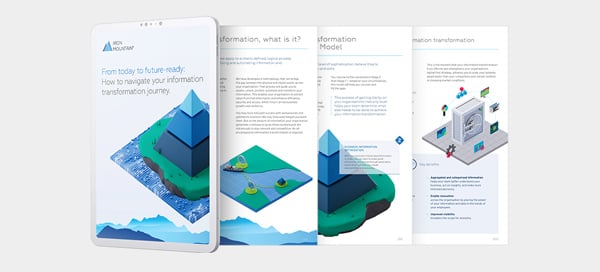Closing gaps. Opening doors.
Many organisations, regardless of size or level of sophistication, believe they’re appropriately managing their information and data. Our experience shows that this is not always the case.

Our experience shows that there’s often some areas that go unaddressed when leaders look to tackle this initiative. To manage those gaps, we’ve developed a clear and proven model within the information transformation process to help you on your journey to deliver information transformation.
The Maturity Model comprises three distinct stages that will help your team clarify where you are on your journey, what changes have already been made and what’s left to do to meet the needs of your digital-first business. Whatever your circumstances, this guide will help you uncover and fill the gaps.
Download our guide to find out where your organisation sits on the information transformation maturity spectrum.
Featured services & solutions
Information is one of your organisation’s most valuable assets
Information drives every decision you make in business, that’s why it’s one of your most valuable assets. The information you have and how you use it to drive growth and innovation allows your organisation to differentiate itself from competitors and stand out in the market.
Today’s organisations must navigate an ocean of growing data and information. As businesses adopt a digital-first model to stay relevant and competitive, the information management challenge comes more sharply into focus and throws up several concerns.
Organisations are finding accessibility and storage of that information to be an ongoing challenge. And the problem is not confined to individual business units, this is an organisation-wide challenge that impacts every decision, every day.
For more than 70 years, Iron Mountain has partnered with businesses to care for their information and assets. We’re the company protects your data and unlocks its value. Over that time, we’ve observed that the high costs and extensive resources involved in storing and managing their data – physical and digital – is a key concern. Organisations are grappling with constantly changing regulatory requirements across multiple jurisdictions and the ever-growing risk of data breaches.
Leaders are also keen to automate functions, improve efficiencies, and make their valuable information and data more accessible to their entire workforce no matter where they are.
And of course, much like us, all these organisations are seeking more sustainable ways to manage and store their data. It’s important to them, it’s important to their customers and their shareholders.
Many businesses say it’s a complex and overwhelming task, and they don’t know where to start. So, what is the organisation-wide solution to managing your company’s valuable information in a digital-first economy?
Information transformation.
Let us explain how it works.
Related resources
View More Resources
Circularity is the new IT imperative

The Benefits of E-Waste Management Go Beyond the Environment
Want to continue exploring?
Enter your information to access the full content.
